Author: Eual A. Phillips
School/Organization:
Hill-Freedman World Academy
Year: 2017
Seminar: What is the Earth Made of?
Grade Level: 9-12
Keywords: Chemistry, compounds, coordination, covalent, crystals, earth, endangered elements, Environmental Science, green chemistry, ionic, Math, minerals, molecular geometry, physics
School Subject(s): Chemistry, Environmental Science, Geology, Science
Our earth is a complex system of definite composition. How we distribute the matter across the earth has become a notorious topic in the developing field of green chemistry. This unit explores the topic by conducting in-depth studies of endangered elements, rare earth elements, and mineral sources. Students will learn about how to use the periodic table to predict geometries and coordination of compounds. Ultimately, students will engage in wet chemical techniques used to create synthetic minerals and investigate the applications of minerals in their semi-native form. Overall, this unit gives opportunity for students to develop science literacy and environmental consciousness while learning about patterns observed in the periodic table.
Did you try this unit in your classroom? Give us your feedback here.
There are many elements on the periodic table lending themselves to the composition of many ionic minerals in the lithosphere of the earth. However, the high school chemistry curriculum has not gone deep enough in the extraction process. Students are still performing routine chemical experiments, have not yet unlocked the potential of how those reactions have truly advanced our society. I believe the key to helping students understand ionic compounds is to give them diverse instructional approaches that bring them beyond the knowledge of everyday table salt. Overall, the aim of this unit is to investigate new chemistry techniques that have been developed over the past 15-20 years by introducing those techniques into the classroom to replace mundane experiments with experiments developed with the intent of solving a problem or meeting a need.
I am a teacher that loves creating new things and performing new tasks. However, I feel that the curriculum in the school district of Philadelphia really keeps chemistry teachers at the foundational level of chemistry. When I examine the curriculum, I realize that it is nearly identical to what I learned in school 15 years ago. As a teacher of a new generation of students, I feel obligated to teach students new ways of doing things. I believe it is a huge disservice to my students to offer them the exact same curriculum that I had when I was in high school, when the truth is that they deserve better. If I am not living up to that task, then that means my university degrees and professional accomplishments carry no weight or power because I have not attempted to impart even a fraction of what I have learned from my professional experiences to the next generation of high school students. Failure to impart these experiences means that I am actually sending my students back in time to a darker past instead of advancing them towards a brighter future. Some laboratory experiments will always be considered the classics, such as the flame test lab and electrical conductivity of salts, which establishes foundation for understanding. However, if science is advancing, but the laboratory experiments in high school remain the same, then students will always be living in the past. When I was completing my bachelor’s degree in chemistry, I chose to investigate the applications of synthetic hydroxyapatite coatings on biomedical implants, which required me to personally synthesize variants of the mineral. Therefore, the inspiration for the design of this unit is to teach students how to synthesize minerals or materials and investigate their applications. The other piece of inspiration driving this unit is my students’ desire for more than what the suggested textbook offers. When teaching ionic bonds, students have asked questions that break past the basic barrier of binary compounds. Some of them want to know whether multiple cations and anions can be used to create compounds. I believe that this seminar opens the door for me to comfortably introduce and teach about ionic compounds containing more than two types of ions, which involves minerals and materials. I believe that when we simply do solution chemistry and pour the chemicals down the drain after the experiments are over, we are doing a huge disservice to our students, implying that the very thing we created in class has no use or purpose but to go down the drain. I owe it to my students to show them the complete beauty of chemistry, that happens beyond the test tube.
Student Audience: The unit is intended for students in grade 10, who attend classes together as an advisory. Students have 60-minute class periods three days per week and 50-minute class periods twice weekly. An estimated 85% of the students will be enrolled in algebra II, while the remaining students will be enrolled in geometry. The students enrolled in geometry are in the same advisory. Grade 10 students are also committed to the completion of a personal project as a requirement for finishing the International Baccalaureate (IB) Middle Years Program (MYP). Some lessons and activities may be suitable for environmental science. Key and Related Concepts: In IB MYP, key concepts are words used to paint a broad picture of learning expectations that can be observed within and across disciplines. There are three fundamental key concepts that IB recommended in science: change, relationships, and systems. Of the three fundamental key concepts recommended by IB (change, relationships, and systems), this unit will focus on the key concept of change. Related concepts are more discipline-specific and allow for exploration of the key concepts in greater detail to cultivate students’ conceptual understanding. The two related concepts selected for this unit’s presentation are form and identity. Conceptual Phrase: The conceptual phrase is a generic statement that summarizes a concept, is nonspecific, and can be applied across multiple content areas and topics. The conceptual phrase developed for this unit is as follows: Systemic changes influence form and/or identity. This conceptual phrase can be translated to other topics, such as physical and chemical changes, thermodynamics, ion formation, or the redox reactions. Thus, students benefit from learning conceptual phrases because they potentially bring the familiarity of older content into new content. Global Contexts: The global context describes the direction of the content and how students will purposefully and meaningfully engage the content. For this unit, the global context will focus on scientific and technical innovation, by which students will explore the natural world and its laws and how humans use their understanding of scientific principles. Students will begin the unit by learning about the basics of the periodic table and periodicity. Then students will be asked to apply the patterns observed in periodicity to the formation of compounds and minerals. Students will then be challenged to synthesize synthetic variations of minerals and explore some of the possible applications. Inquiry Statement: The inquiry statement is comprised of the key and related concepts, the conceptual phrase, and the primary global context. It is provided to the students so that they may know the direction of the unit. The inquiry statement addresses what the student should expect to learn and why they should learn the forthcoming content. The inquiry statement derived for this unit is as follows: Studying changes and their influence on form and identity of minerals have helped humans understand the applications of minerals and develop an increased awareness of environmental issues. Inquiry Questions: Inquiry questions are provided for students as a guide to their learning expectations. They are not necessarily exam questions, but they ought to provoke students into learning the content. Below are the several examples of inquiry questions that can be used throughout the unit. Factual Questions: Conceptual Questions: Debatable Questions: The Objectives of the unit will include, but are not limited to the following:
The foundation of this unit will focus on green chemistry. Research will begin with green chemistry and why this discipline is important in sustainability. Secondly, we must understand what chemical techniques scientists are using in order to promote and drive green chemistry practices. The chemical elements are neither evenly nor fairly distributed across the globe and. Thus, a teacher of this unit ought to know the relative abundances of some of the most common elements used on the planet. Since most of our chemicals are extracted from ores mined from the earth, some of those sources have already been depleted while others are reaching exhaustion. Thus, it raises the question whether or not humanity is ready to move from the recycling of paper, plastics, and water toward recycling anything and everything. This means raising up a generation of people who are becoming environmentally responsible through the power of science literacy. Thus for this unit, one aspect that I chose to focus on is the artificial synthesis of minerals, since minerals are the original vessel of choice upon the creation of the earth to store elements until their appointed time of discovery. The mineral of choice for this study is malachite. Scientists have used chemistry to recycle elements back to a synthetic mineral in order to increase access to other rare compounds, such as metal oxides. To prepare myself for this unit, I had to find the availabilities of elements in the earth’s crust and their distribution across different geographical regions. Secondly, I needed to refresh my knowledge of coordination chemistry of compounds. Finally, I had to conduct research on the latest wet chemistry techniques developed in the past 15-20 years that produce synthetic forms of the minerals, which will provide opportunity for more diverse laboratory experiments. Overall, I want the students to experience the power of materials science in the classroom, rather than teaching about salts. In chemistry, we know that two laws are always at work: conservation of mass and energy. This means that the amount of matter available in the earth is finite with the exception of sending equipment to explore space and occasional meteors entering our planet’s atmosphere every few hundred, thousand, or million years. Commonly, politics has directed our attention toward global warming and managing our carbon and water footprints. However, with our increasing dependence on technology, is our society truly moving towards sustainable management of resources? Technology is heavily dependent on transition metals and some rare earth elements. Minerals are constantly being extracted from the earth for our technological benefit, but what will be our future. As of early 2016, 118 elements have been discovered and named, but 44 of those elements have been classified as “endangered elements” considering that they will be in short supply in the near future.[1] The list of elements include zinc, gallium, germanium, helium, silver, phosphorus, and all of the rare earth elements. In an effort to raise awareness of elemental exhaustion, the Royal Society of Chemistry has published a book entitled, Element Recovery and Sustainability. However, we know that these elements are not disappearing based on the law of conservation of mass. They are simply being redistributed out of the earth across the human population. Thus, when an element is labeled endangered, it means that access to these elements will be extremely limited as their natural sources become depleted. For example, indium is commonly used in cell phones and only a few milligrams are needed in each device. Since so little is needed, the recycling of phones to reharvest this element is not very cost effective.[2] Copper containing compounds have always provided excellent platforms to educate students in chemistry. This unit contains a relatively new laboratory experiment focused on copper minerals. Malachite is a mineral composed of copper, carbonate, and hydroxide ions with a chemical formula of Cu2CO3(OH)2. It is often found with its relative, azurite, which has a composition of Cu3(CO3)2(OH)2. Malachite was first harvested from King Solomon’s mines located in the Timna Valley of Israel, located south of Iran. However, the highest quality malachite was discovered in the Ural Mountains of Russia. During the early and mid 19th century, malachite was primarily used as a dye for paints, which is evident in the green rooftops of homes near the Ural Mountains. On the other hand, Europeans valued malachite for its aesthetic appeal, using it to assemble mosaics containing other colorful minerals. Eventually, malachite found uses in decorative furniture and houseware items such as tabletops and silverware. Eventually, malachite deposits were depleted, causing scientists search for methods to reproduce natural malachite. It was not until the second half of the 20th century that scientists began to truly understand the chemical structure of malachite and use those physico-chemical properties to devise methods of synthesis. Early materials science application of malachite was noted in Medieval writings. In those writings, malachite was referred to a chrysocolla, is a composition of the Greek words chryso (gold) and colla (glue), meaning that malachite was used to solder gold. However, the name chrysocolla has be reassigned to copper silicates[3]. As of 2009, scientists are still refining their search for malachite synthesis techniques. Saha et al. have sought to exploit the pH-specific adsorption behavior and adsorption capacity of malachite nanoparticles as a biomaterial for bioseparation technology and biochemical sensor development.[4] Their research has shown that BSA has a higher adsorption affinity toward bare malachite nanoparticles than toward malachite nanoparticles modified with stearic acid. Similar studies are being reported for the removal of arsenate and chromate ions.[5] Interestingly, malachite is also under investigation as a water decontaminant. However, as mentioned in regards to the biotechnology, malachite’s mechanism of water decontamination focuses on its adsorptive characteristics. Malachite can be precipitated via the following reaction by keeping the pH of the stock solution at 7.0 ± 0.5. 2 CuCl2 + 2 Na2CO3 + H2O → Cu2(OH)2CO3↓ + CO2↑ + 4 NaCl (Du et al.)[6] At the end of this curriculum unit, I have provided a laboratory activity where students can synthesize malachite and other structural variants of the mineral and web resources for students to conduct research on copper minerals. [1] Endangered Elements. (n.d.). Retrieved April 01, 2017, from https://www.acs.org/content/acs/en/greenchemistry/research-innovation/research-topics/endangered-elements.html [2] Chattopadhyay, D. (2017). Endangered elements of the periodic table. Resonance, 22(1), 79-87. [3] Gettens, Rutherford J., and Elisabeth West Fitzhugh. “Malachite and Green Verditer.” Studies in Conservation, vol. 19, no. 1, 1974, pp. 2–23., www.jstor.org/stable/1505631. [4] Saha, Bedabrata, and Gopal Das. “Malachite nanoparticle: a New basic hydrophilic surface for pH-controlled adsorption of bovine serum albumin with a high loading capacity.” The Journal of Physical Chemistry C 113.35 (2009): 15667-15675. [5] Saikia, Jiban, Bedabrata Saha, and Gopal Das. “Efficient removal of chromate and arsenate from individual and mixed system by malachite nanoparticles.” Journal of hazardous materials 186.1 (2011): 575-582. [6] DU, Ying-ji, et al. “Preparation of Basic Copper Carbonate Microspheres by Precipitation Method.” (2015).Green Chemistry
How are we practicing green chemistry?
Copper Minerals
Implementing this Unit: This unit does not necessarily have to be taught as a standalone unit. The intent of this unit is to provide added variety to student learning and to create content overlap. Typically, I spend about a week allowing my students to learn about the periodic table’s families and periodicities. The first classroom activity can be used as summative assessment for the periodic table, providing an opportunity for students explore the applications of endangered elements and reflect on the environmental impacts of harvesting elements from the earth. The second classroom activity will focus on using periodicity to explain how ionic compounds obtain their crystal geometries or coordinations. This activity can be taught after ionic compounds or after valence-shell electron-pair repulsion theory. Ionic compounds tend to favor octahedral and cubic geometries, while covalent compounds tend to favor tetrahedral, trigonal, and linear. Thus, you can choose to split the second activity across distinctively between those two types of bonds. The final activity allows students to act as a materials scientist and fabricate a synthetic mineral. Since many minerals are composed of polyatomic ions, the mineral synthesis also serves as a summative assessment for ionic compounds. This unit will use a variety of strategies to help students grasp the concepts. The first strategy is breaking the timeline of the curriculum. I believe that there are topics that just need to be introduced earlier because I believe they will strengthen the understanding of the students. I do not teach International Baccalaureate (IB) diploma program chemistry, but materials science is an optional unit taught near the end of the IB course. Thus, concepts of materials science will be sprinkled into the curriculum earlier to add more depth and to take student understanding of ionic compounds past their limited perception of salts and into materials science applications. The second strategy is to use the appropriate chemistry methods available to bring the materials application to life in the classroom. This will be entirely dependent upon what universities have published regarding the synthetic replicates of earth’s minerals and their fabrications for materials applications. The last strategy is to use a systems and societies approach to expose students to how the availability of minerals across the globe has influenced the environment and the economy. This too is dependent upon the research that universities have published and whether human activity and values have stimulated the search for the development of various materials derived from minerals. Assessment Objectives: The IB Middle Years Program (MYP) requires that students are assessed according to four criteria. These criteria are defined as (a) knowing and understanding, (b) inquiring and designing, (c) processing and evaluating, and (d) reflecting on the impacts of science. Activities presented in this curriculum unit will primarily assess strands in criteria a and d. Approaches to Learning
There are only a limited supply of elements available on the earth. Recently, chemists have been tracking the availability of elements and their consumption to find that some elements have become endangered. You will study the sources of elements and answer the following questions. In teams of 2-3, you are responsible for creating an infographic about an endangered element. Be sure to explain how the element is used, why is it becoming scarce, and alternatives available in the event that the element is exhausted from the planet. Criterion A: Knowing and Understanding (some specific landmarks) Criterion D: Reflecting on the Impacts of Science criterion 1 criterion 2 criterion 3 criterion 4 (1 clearly identified source). (4 clearly identified sources). The purpose of this lesson is to show students how the size of atoms helps predicting their crystal geometries (ionic compounds) and molecular geometries (covalent compounds). It requires students to apply their knowledge of ionic sizes to make sense of the compounds formed. The key thing students need to be warned of prior to this lesson is that ionic bonds and covalent bonds are very different. The chemical formula of an ionic compound does not foreshadow any geometries. However, the chemical formula of a covalent compound correlates well to their predicted geometries. This comes down to making sure that students know that ionic bonds rely on forces of attractions while covalent bonds rely on sharing of electrons. At the conclusion of this lesson, students will be able to: Periodic tables, calculators, PowerPoint slides, printed or electronic worksheets This should be a review for your students after having demonstrated mastery of periodicity. Directions Calculate the radius ratio for each ionic compound. Then determine the coordination number (CN) and the type of polyhedron formed between the ion pair. Table 1: Common Cations and Anions Table 2: Transition Metals Table 3: Covalent Bonds Table 4: Rare Earth Elements Conclusion Questions Summary In this lesson, students will attempt to synthesize a semi-precious mineral. This mineral has been used for aesthetic applications in jewelry, furniture, and silverware. At the end of this lab, students should prepare a group lab report addressing either the environmental/economic impacts of mining endangered elements or the biotechnological applications of the mineral. The goal of this lab activity, in addition to all the objectives, is to show students that they can make a material that is useful for humanity and actually has an application beyond a simple demonstration that reinforces a chemistry concept. Objectives At the conclusion of this lesson, students will be able to Teacher Preparation 30-45 minutes handling materials. Lesson: 90 minutes or 2 class periods Materials Safety Teacher Notes This section includes any information the teacher might need, including Laboratory Environment Preparing Stock Solutions – Teacher Setup Copper WebQuest Web Quest Prompts Supplement – Pictures of Lab Setup Malachite precipitate at bottom of an Erlenmeyer flask Malachite powder in filter paper Malachite powder in glass jar Optional Extension Rosasite Cu1.5Zn0.5CO3(OH)2 Black Rosasite CuxZn2-xCO3(OH)2 contains higher proportion of Cu:Zn than Rosasite Kolwezite Cu1.34Co0.66CO3(OH)2 Cobalt Carbonate Hydroxide Co2CO3(OH)2 Background Malachite (Cu2(OH)2CO3) is a semi-precious mineral that has been harvested from many years going back to reign of King Solomon of Israel. However, the most eye-catching malachite comes from the Ural Mountains in Russia. Copper is typically extracted from malachite and its chemical relative, azurite. Unfortunately, many of the mines containing malachite have been depleted and scientists are beginning to admire its biotechnological and biomaterial applications. To meet the demand for these revolutionary applications, chemists have developed simple methods to artificially reproduce the mineral. The equation for the chemical reaction you will perform is as follows: 2 CuCl2 + 2 Na2CO3 + H2O → Cu2(OH)2CO3(s) + CO2(g) + 4 NaCl(aq) 2 CuSO4 + 2 Na2CO3 + H2O → Cu2(OH)2CO3(s) + CO2(g) + 2 Na2SO4(aq) Since malachite is a more complex ionic compound, a simpler compound, copper(II) carbonate, will form first. When the water absorbs enough heat energy, free copper(II) ions will begin to form copper(II) hydroxide. Both compounds are light blue in their appearance so there is no way to determine exactly when copper(II) hydroxide begins to form. When enough copper(II) hydroxide accumulates and reactants begin to equilibrate and organize into the correct ratio, they will unite to form the dark green malachite. Prelab Questions Problem/Objective In this experiment, you are going to replicate an experiment that materials scientists began in the 1960s, but have recently perfected in the past 10 years. You will synthesize malachite particles. Materials Safety Procedure Measure 5 mL of 0.5M copper(II) chloride in a 10-mL graduated cylinder. Add it to your Erlenmeyer flask. Stir vigorously using a glass stirring rod. If a glass stirring rod is not available, gently swirl the Erlenmeyer flask. Add copper(II) chloride solution in 5-mL portions. Stir vigorously after each addition with a glass stirring rod (or with gentle swirling). Continue adding your copper-containing solution in 5-mL increments until you use all 50 mL. Measure the mass of a sheet of filter paper. Record this mass in the data table. When all solutions have been added to your Erlenmeyer flask and you see a dark green precipitate your reaction is complete. Using a balance, measure the mass of a sheet of filter paper. Using a second 250-mL Erlenmeyer flask, glass funnel, and filter paper, filter the precipitate using a glass funnel and filter paper. Using a plastic pipette, rinse your filter paper containing the malachite precipitate with ~10 mL of distilled water. Repeat the rinse with ~10 mL of methanol. Give your glass funnel to your teacher for overnight drying and storage. On the following day, obtain your filter paper covered with malachite and measure the mass of the dried filter paper containing malachite powder. Record this mass in the data table. Continue to perform the calculations Results/Data/Observations Calculations Calculate the mass of malachite powder by subtracting the mass of the filter paper from the mass of the filter paper containing malachite powder. Record in the data table. Calculate the percent yield of malachite powder using the theoretical yield calculated from the prelab questions and your experimental mass of malachite powder. Record the results in the data table. Conclusion Conduct research on copper as an endangered element. To what extent has mining affected the environment and the economy? Conduct research on malachite used as a biomaterial. Use the articles provided by the teacher. Do not be confused with malachite green dye, which is an organic dye.Activity: Endangered Element Poster Project
List of Endangered Elements
Helium
Indium
Gallium
Silver
Uranium
Germanium
Arsenic
Zinc
Hafnium
Platinum
Phosphorus
Lithium
Recommended Websites
Locations of Deposits
http://web.mit.edu/12.000/www/m2016/finalwebsite/solutions/deposits.html
Rare Earth Element Mines, Deposits, and Occurrences
https://mrdata.usgs.gov/ree/
Criteria to be addressed on your poster
Rubrics for Endangered Element Poster
Criteria
1–2
3–4
5–6
7–8
Location Source
1 country (nonspecific landmark)
2 countries (nonspecific landmark)
3 countries
3 countries (with specific landmarks)
Mineral Source
1 mineral containing EE.
2 minerals containing EE.
3 minerals containing EE.
4+ minerals containing EE.
Advantages
1 Advantage
1-2 Advantages
2 Advantages
3 Advantages
Disadvantages
1 Disadvantage
1-2 Disadvantages
2 Disadvantages
3 Disadvantages
Alternative Elements
1 suggested alternative
1-2 suggested alternatives
1 convincing alternatives
2 convincing alternatives
Future of element
No Prediction made on future use/ availability
Prediction made on future use OR availability lacking detail
Prediction made on future use/ availability lacking some detail
Prediction made on future use/ availability
Pictures of sources/visuals
No pictures
1-2 inaccurate pictures
1 picture
2 pictures
Disorganized and rushed.
Organized, colorful, but rushed.
Organized, colorful, but slightly rushed or incomplete.
Well-organized, colorful, and looks complete.
Achievement Level
1–2
3–4
5–6
7–8
Sub-
Outline the ways in which endangered element is used to address a specific problem or issue
Summarize the ways in which endangered element is applied and used to address a specific problem or issue
Describe the ways in which endangered element is used to address a specific problem or issue
Explain the ways in which endangered element is applied and used to address a specific problem or issue
Sub-
Outline the implications of using endangered element (and any available substitutes) to solve a specific problem or issue, interacting with a factor
Describe the implications of using endangered element (and any available substitutes) to solve a specific problem or issue, interacting with a factor
Discuss the implications of using endangered element (and any available substitutes) to solve a specific problem or issue, interacting with a factor
Discuss and evaluate the implications of using endangered element (and any available substitutes) to solve a specific problem or issue, interacting with a factor
Sub-
Apply scientific language to communicate understanding
Sometimes apply scientific language to communicate understanding
Usually apply scientific language to communicate understanding clearly and precisely
Consistently apply scientific language to communicate understanding clearly and precisely
Sub-
Document sources
Sometimes document sources correctly (2 clearly identified sources).
Usually document sources correctly (3 clearly identified sources).
Document sources completely
Command term
Definition
Apply
Use knowledge and understanding in response to a given situation or real circumstances. Use an idea, equation, principle, theory, or law in relation to a given problem or issue.
Describe
Give a detailed account or picture of a situation, event, pattern, or process.
Discuss
Offer a considered and balanced review that includes a range of arguments, factors, or hypotheses. Opinions or conclusions should be presented clearly and supported by appropriate evidence.
Document
Credit sources of information used by referencing (or citing), following one recognized referencing system. References should be included in the text and also at the end of the piece of work in a reference list or bibliography.
Evaluate
Make an appraisal by weighing up the strengths and limitations.
Explain
Give a detailed account including reasons and causes.
Outline
Give a brief account or summary.
Summarize
Abstract a general theme or major point(s).
Lesson: Coordination Chemistry of Ionic Compounds
Purpose
Lesson Objectives
Materials and Equipment
Do Now Activity
Introduce Lesson
Table of common coordination numbers, shapes, and radius ratio classifications
Coordination Number
Polyhedron
Radius Ratio (min)
12
Irregular
> 1.000
8
Cube
0.732 – 1.000
6
Octahedron
0.414 – 0.732
4
Tetrahedron
0.225 – 0.414
3
Triangle
0.155 – 0.225
2
Line
< 0.155
Student Worksheet
Chemical Formula
Cationic Radius
Anionic Radius
Radius Ratio
Coord. Number
Polyhedron
NaF
102
133
0.767
8
Cube
NaCl
102
181
NaBr
102
195
NaI
102
220
CaCl2
100
181
CaBr2
100
195
Ca(OH)2
100
133
Ca3(PO4)2
100
238
Chemical Formula
Cationic Radius
Anionic Radius
Radius Ratio
Coord. Number
Polyhedron
FeO
61
140
FeCl2
61
181
FeCO3
61
178
Fe(OH)2
61
133
CuCO3
77
178
0.459
6
Octahedron
Ag2O
115
140
FeCl3
55
181
Chemical Formula
Central Ion Radius
Anionic Radius
Radius Ratio
Coord. Number
Polyhedron
(SO4)2–
38
140
(NO3)1–
27
140
(PO4)3–
58
140
CO2
16
140
(SiO4)4–
40
140
(IO4)1–
69
140
Chemical Formula
Cationic Radius
Anionic Radius
Radius Ratio
Coord. Number
Polyhedron
Sc2O3
38
140
Eu2O3
27
140
Er2O3
58
140
LaF3
106.1
133
HoI3
89.4
220
SmCl3
96.4
181
Question/Prompt
Response
1
Which geometries/shapes do common ionic compounds favor?
2
Which geometries/shapes do compounds containing transition metals favor?
3
Which geometries/shapes do common covalent compounds favor?
4
Which geometries/shapes do rare earth elements favor?
Lab: Chemical Recycling – Synthesis of Malachite and Related Minerals
For the Teacher:
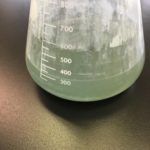
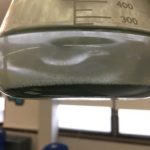
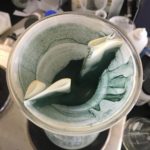
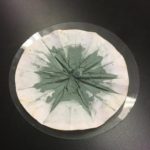
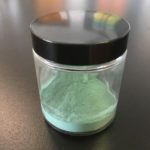
Other Derivatives of Malachite
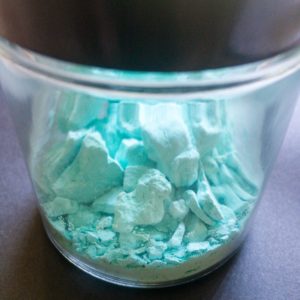
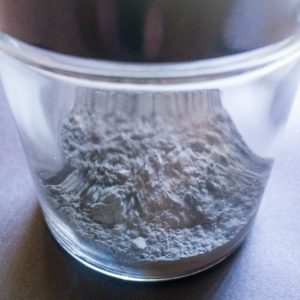
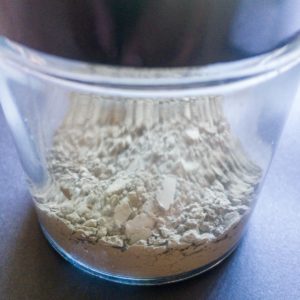
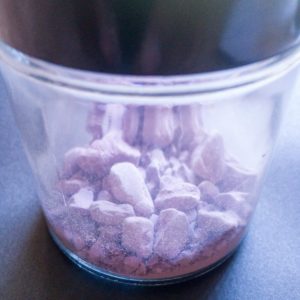
For the Student
Chemical Recycling – Synthesis of Malachite
Mass of Filter Paper (g)
Mass of Dried Filter Paper with Malachite Powder (g)
Experimental Mass of Malachite Powder (g)
Percent Yield of Malachite Powder
Teacher Resources Endangered Elements. (n.d.). Retrieved April 01, 2017, from https://www.acs.org/content/acs/en/greenchemistry/research-innovation/research-topics/endangered-elements.html Chattopadhyay, D. (2017). Endangered elements of the periodic table. Resonance, 22(1), 79-87. Gettens, Rutherford J., and Elisabeth West Fitzhugh. “Malachite and Green Verditer.” Studies in Conservation, vol. 19, no. 1, 1974, pp. 2–23., www.jstor.org/stable/1505631. Background reading material on malachite mineral. Saha, Bedabrata, and Gopal Das. “Malachite nanoparticle: a New basic hydrophilic surface for pH-controlled adsorption of bovine serum albumin with a high loading capacity.” The Journal of Physical Chemistry C 113.35 (2009): 15667-15675. Potential application of malachite synthesis. Saikia, Jiban, Bedabrata Saha, and Gopal Das. “Efficient removal of chromate and arsenate from individual and mixed system by malachite nanoparticles.” Journal of hazardous materials 186.1 (2011): 575-582. Potential application of malachite synthesis. DU, Ying-ji, et al. “Preparation of Basic Copper Carbonate Microspheres by Precipitation Method.” (2015). Xu, Jiasheng, and Dongfeng Xue. “Fabrication of malachite with a hierarchical sphere-like architecture.” The Journal of Physical Chemistry B 109.36 (2005): 17157-17161. Cris E. Johnson, Gordon T. Yee, and Jeannine E. Eddleton. Copper Metal from Malachite circa 4000 B.C.E. Journal of Chemical Education 2004 81 (12), 1777. DOI: 10.1021/ed081p1777. Background reading material on malachite mineral. S. Parekh and A. C. T. Hsu. Preparation of Synthetic Malachite. Reaction between Cupric Sulfate and Sodium Carbonate Solutions. I&EC Product Research and Development 1968 7 (3), 222-226. DOI: 10.1021/i360027a015 Student Resources The Chemistry Behind the Minerals. https://www.youtube.com/watch?v=dS8za4jGcUA&spfreload=5 Locations of Deposits. (n.d.). Retrieved July 06, 2017, from http://web.mit.edu/12.000/www/m2016/finalwebsite/solutions/deposits.html. Website is an excellent resource for learning about the availability of endangered elements across the globe. Program, M. R. (n.d.). Rare earth element mines, deposits, and occurrences. Retrieved July 06, 2017, from https://mrdata.usgs.gov/ree/ . Website contains GIS maps, databases, and search engines tailored for rare earth element research. Copper. (n.d.). Retrieved April 26, 2017, from https://mineralseducationcoalition.org/minerals-database/copper/ Copper. (n.d.). Retrieved April 26, 2017, from https://mineralseducationcoalition.org/elements/copper/ Medical Uses of Copper in Antiquity. (n.d.). Retrieved July 06, 2017, from https://www.copper.org/publications/newsletters/innovations/2000/06/medicine-chest.html Copper.org – Copper Facts. (n.d.). Retrieved July 06, 2017, from https://www.copper.org/education/c-facts/facts-print.html
School District of Philadelphia Standards Assess and apply patterns in science and technology. Explain concepts about the structure and properties of matter. Relate earth features and processes that change the earth. Explain sources and uses of earth resources. Analyze the availability, location, and extraction of earth resources. Scientific Investigations Next Generation Science Standards HSN-Q.A.1 Use units as a way to understand problems and to guide the solution of multi-step problems; choose and interpret units consistently in formulas; choose and interpret the scale and the origin in graphs and data displays. (HS-PS1-3),(HS-PS1-8),(HS-PS2-6) HSN-Q.A.2 Define appropriate quantities for the purpose of descriptive modeling. (HS-PS1-8),(HS-PS2-6)
Anchor Descriptor
Core Standard
3.1.12.C
3.4.10.A
3.5.10A
3.5.10.B
3.5.12.B
3.8.12.C: Evaluate the consequences and impacts of scientific and technological solutions.
3.2.C.A6
Anchor Descriptor
Core Standard
HS. Structure and Properties of Matter
HS-PS2-6. Communicate scientific and technical information about why the molecular-level structure is important in the functioning of designed materials.
HS. Waves and Electromagnetic Radiation
HS-PS4-5. Communicate technical information about how some technological devices use the principles of wave behavior and wave interactions with matter to transmit and capture information and energy.
Anchor Descriptor
Core Standard
ELA/Literacy
RST.9-10.7 – Translate qualitative or technical information expressed in words in a text into a visual form and translate information expressed visually or mathematically into words.
Mathematics
MP.2 – Reason abstractly and quantitatively. (HS-PS4-1), (HS-PS4-3)